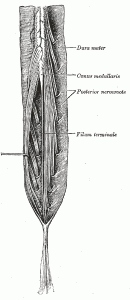Conus Medullaris Definition
Page Contents
Medical researchers define Conus Medullaris as the name given to the conical extremity of the Medulla Spinalis (spinal cord). At the pointed end of this bone, the nerve roots of the spinal cord continue to dangle in a formation called the cauda equina. The unique name of the formation comes from the fact that it looks similar to the tail of a horse. As the conus medullaris is situated at terminal end of the spinal cord in the lower back, trauma or lumbar spinal conditions can affect it.
The word is pronounced as “Cone-us Medu-lae-reece”.
Conus medullaris Syndrome
It refers to a collection of symptoms that arise due to damage to the Conus medullaris. The condition usually develops when the nerves in the conus medullaris find it unable to function correctly as a result of constriction of the lower part of the spinal column or undue pressure. Compression may also occur due to other problems like
- Tumor
- Hematoma (localized swelling filled with blood)
- Constriction of the lumbar vertebra
- Injury to the spinal cord
- Spinal cord inflammation due to infection
Other less common factors involve congenital problems that lead to:
- Malformation of the Conus Medullaris
- Multiple sclerosis
- Deep vein thrombosis in the veins that are associated with the spinal cord
Conus Medullaris Syndrome Symptoms
The main symptoms of Conus medullaris syndrome involve discomforts like:
- Numbness in the lower body parts, such as foot, groin and inner thigh
- Weakness in leg
- Difficulties in walking
- Loss of bladder control
- Low back pain
- Impotence
Conus Medullaris Anatomy

Picture 1 – Conus Medullaris
Source – wikimedia
It is usually located between the root of the lumbar vertebrae (L-1) and the finish of the thoracic vertebrae (T-12). Sometimes, however, it can be found in the position between L-1 and L-2.
Cauda Equina and Conus Medullaris
Cauda Equina Syndrome is the name given to a characteristic pattern of urogenital and neuromuscular symptoms that arise due to the simultaneous compression of multiple lumbosacral nerve roots that are located under the level of the Conus Medullaris.
The symptoms of Cauda Equina Syndrome include
- Low back pain
- Bladder problems
- Bowel dysfunction
- Sciatica (unilateral or bilateral, though the latter one is more common)
- Saddle sensory disturbances
- Loss of motor functioning and sensations in the in the lower extremity
Conus Medullaris Termination
In some children, significant variability is found in the termination of the Conus Medullaris (CM). A small percentage of individuals are found to have CM as low as the middle part of L4.
Conus Medullaris Vs Cauda Equine
Read and know about the main differences between Conus Medullaris Syndrome (CMS) and Cauda Equine Syndrome (CES).
Presentation
The presentation is sudden and bilateral in CMS while is it gradual and unilateral in CES.
Reflexes
CMS affects only ankle jerks while CES affects knee as well as ankle jerks.
Low Back Pain
Pain in the lower back region is more in case of CMS patients. Individuals with CES usually have less pain or no pain at all.
Radicular pain
The radicular pain is less severe in CMS while it is more severe in individuals with CES.
Sensory symptoms
The numbness, in case of CMS patients, tends to be more localized to perianal region. However, it is usually more localized to the saddle region in CES patients.
Motor strength
The motor strength is generally symmetric and involves less pronounced Hyperreflexic Distal Paresis of the lower limbs. CES involves more pronounced cases of Asymmetric Areflexic Paraplegia. Fasciculations may be present in CMS patients while they are rare in CES individuals.
Impotence
Both CMS and CES involve impotence. However, the frequency of impotence is more frequent in CMS patients than in individuals affected with CES. However, CES involves other sexual problems like erectile dysfunction, lack
of sensation in the groin region, inability to ejaculate and inability to maintain erection.
Urinary incontinence
CMS involves urinary incontinence in sufferers who find it unable to hold urine in their bladder for long periods of time. The urine tends to overflow in such individuals. However, CES does not involve any problem with urinary incontinence.
Conus Medullaris at Birth
The Conus Medullaris (CM) is mostly found at the level of L3 at birth. It usually rises to L3 at the time of birth and to L1-2 by the time a child is about 3 months old.
Conus Medullaris and Herniated Disc
Conus Medullaris Syndrome (CM) is also found to occur as a result of an intradural disc herniation. In rare cases, it may also develop from herniated L1-L2 disc following knee arthroscopy. If extrusion of D12-L1 disc is also involved, this may lead to other problems like acute paraplegia. This can often improve after a Durotomy is performed.
Conus Medullaris Ganglioglioma
This is an extremely rare disorder and only 12 individuals have been known to be affected by it so far. Ganglioglioma refers to a glioma or brain tumor. The condition is actually a Conus Medullaris tumor. Complete tumor excision is the best treatment for a ganglioglioma in the CM. It is the chosen method for curing this condition even when surgeons require multiple stage operations for treatment.
References:
http://www.britannica.com/EBchecked/topic/135573/conus-medullaris
http://www.highbeam.com/doc/1G1-173519112.html
http://www.freemd.com/conus-medullaris-syndrome/overview.htm
http://www.ncbi.nlm.nih.gov/pmc/articles/PMC1720669/
